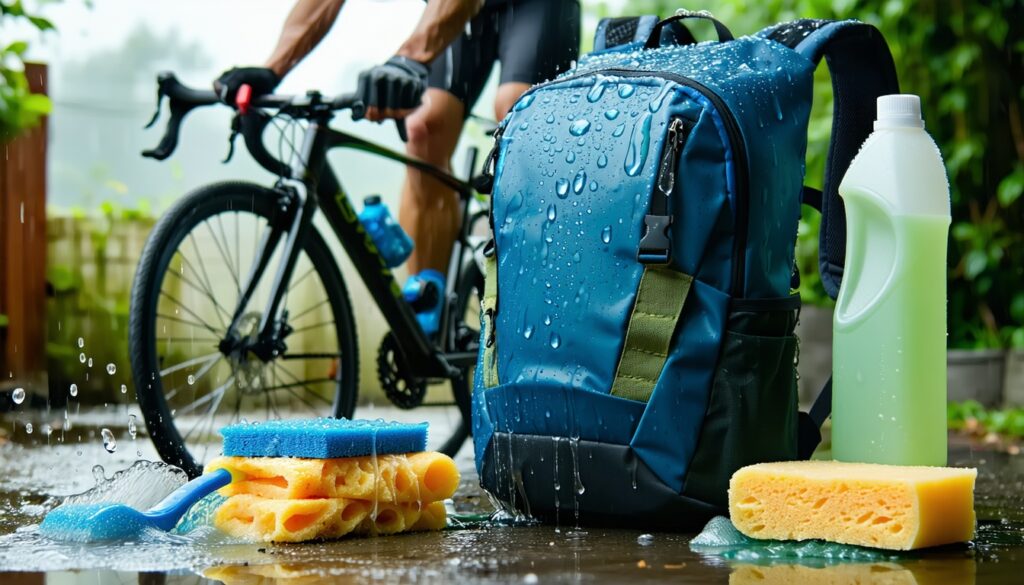How to Clean a Cycling Backpack After Rainy Rides

Cleaning a Cycling Backpack After Rain
Keeping a cycling backpack clean is vital for maintaining its functionality and prolonging its lifespan. After rides in rainy conditions, it is important to follow proper cleaning and maintenance procedures to ensure that your backpack stays in top shape.
Maintenance Tips for Longevity
Regular maintenance is key to keeping a cycling backpack looking great and performing well. Here are some friendly tips:
- Routine Check: After every ride, empty the backpack, shake out any debris, and inspect for any noticeable stains or odors.
- Spot-Treating: Utilize a mixture of one part vinegar to two parts water to refresh your backpack. This natural solution is great for tackling dirty spots or stains.
- Vacuuming: Regularly vacuum the seams, zippers, and pockets to remove dirt and dust. This helps keep the backpack clean without causing damage (Dry Guy Waterproofing).
- Deep Cleaning: Aim for a thorough clean at least one or two times a year to tackle deeper stains and persistent odors.
Basic Cleaning Steps
To clean a cycling backpack effectively after rainy rides, follow these straightforward steps:
| Cleaning Step | Description |
|---|---|
| Empty Backpack | Remove all items from the backpack and check for lost gear. |
| Shake Out Debris | Gently shake the backpack to dislodge any dirt, leaves, or small particles. |
| Rinsing | If the back panel is soaked with sweat, rinse it with warm water to avoid damage from corrosive sweat salts. |
| Wipe Down Exterior | Use a damp sponge or cloth without soap to wipe the backpack’s exterior. |
| Check for Spots | Identify any tough stains and spot-treat them with the vinegar solution. |
| Drying | Air dry the backpack in a well-ventilated area away from direct sunlight. |
By adhering to these maintenance tips and basic cleaning steps, cyclists can ensure their backpacks remain functional and visually appealing. For more insights on practical usage, explore guides on how to choose an ergonomic cycling backpack for comfort and posture or why ventilated back panel matters in a cycling backpack.
Washing a Cycling Backpack
Keeping a cycling backpack clean enhances its longevity and appearance. Understanding how to wash a backpack effectively ensures that it remains in top condition, especially after rainy rides.
Spot-Treating and Refreshing
Spot-treating is an essential method for quickly addressing dirt or stains on a cycling backpack. To do this efficiently, cyclists can utilize a simple mixture of 1 part vinegar to 2 parts water. This solution can refresh the backpack’s appearance and is effective at removing spot stains.
Steps for Spot-Treating:
- Mix the vinegar and water solution.
- Use a clean cloth or sponge to apply the mixture directly to the stain.
- Gently rub the area until the stain lifts.
- Rinse with cold water and blot dry.
For more tips on maintaining gear, consider referencing the article on best practices for organizing your gear in a bike backpack.
Machine Washing Instructions
For those wanting to give their cycling backpack a thorough cleanse, machine washing is a viable option provided the backpack is made from materials like polyester, nylon, or canvas. Before washing, cyclists should always consult the manufacturer’s cleaning recommendations to avoid damaging any leather or delicate components.
Washing Instructions:
| Steps | Instructions |
|---|---|
| Step No 1 | Empty the backpack completely and check all pockets. |
| Step No 2 | Remove any detachable parts, like straps or hydration systems. |
| Step No 3 | Use a gentle cycle with cold water and a mild detergent. |
| Step No 4 | Place the backpack in a mesh laundry bag to protect it during the wash. |
| Step No 5 | Air dry the backpack, avoiding direct sunlight to prevent fading. |
It is essential to avoid machine washing backpacks with leather components, as this can deteriorate the material.
For additional insights, you may find interest in exploring waterproof vs water-resistant: choosing bike-safe backpacks to ensure your backpack remains protected during rainy rides.
Waterproofing a Backpack
When cyclists head out in the rain, having a waterproof backpack can make a significant difference in keeping gear dry. Understanding the types of waterproofing available and how to apply them can help cyclists maintain their backpacks effectively.
Types of Waterproofing
There are several types of waterproofing that can be applied to backpacks, each varying in effectiveness.
| Waterproofing Type | Description | Water Resistance Rating |
|---|---|---|
| Coating | A water-repellant coating is often applied to the fabric, repelling moisture from the surface. | Class 1 & 2 (800 mm – 1300 mm) |
| Membrane | Membrane technologies (like Gore-Tex) provide a barrier against water while allowing breathability. | Class 3 (1300 mm – 2000 mm) |
| Taped Seams | Seams are sealed with waterproof tapes to prevent water from seeping through these vulnerable areas. | Varies based on application |
| Fully Waterproof Fabrics | Fabrics are wholly designed to be waterproof, making them ideal for biking in heavy rain. | Class 4 (>2000 mm) |
Most cycling backpacks are designed to be completely waterproof, protecting against moisture from above, the sides, and even dirt and mud from the ground.
Application Methods
Cyclists can enhance their backpack’s waterproof capabilities through various application methods.
| Method | Description | Frequency of Application |
|---|---|---|
| Waterproof Spray | A spray applied to the fabric creating a water-repellent surface; effective on fabric types. | Every few months or after heavy use |
| Waterproofing Wash | Special detergents that add waterproofing properties when washing backpacks. | After each cleaning |
| Seam Sealing | Applying waterproof tape over seams ensures no water seeps through these critical junctions. | As needed, especially after wear |
Using these waterproofing methods can maximize the performance of a backpack in wet conditions. It’s essential for cyclists to regularly check their gear for wear and reapply treatments as necessary. To learn more about maintaining your backpack, check out our guide on how to clean a cycling backpack after rainy rides.
Keeping Gear Dry in a Backpack
To ensure that cycling gear remains dry during rides in rainy weather, there are several effective strategies cyclists can implement. Utilizing plastic bags, dry sacks, and backpack rain covers can significantly improve protection against moisture.
Plastic Bags and Dry Sacks
Putting individual items into plastic bags or dry sacks within the backpack is a practical approach to keeping gear organized and dry. This method serves as an additional layer of protection, especially in rainy conditions. In the event that the backpack’s main water protection fails, these individual bags act as a backup to safeguard contents.
| Item Type | Description |
|---|---|
| Plastic Bag | Lightweight and resealable, ideal for single items like phones or snacks. |
| Dry Sack | Generally waterproof and designed for more significant gear like clothing or electronics. |
Using various bag types can help with organization and ensure that each item is adequately shielded from potential water exposure.
Backpack Rain Covers
A backpack rain cover is a crucial accessory for cyclists. These lightweight and waterproof covers can easily be slipped over a backpack, providing full protection against rain. For optimal performance during bike commuting, waterproof bicycle panniers, bike baskets with covers, or even multi-functional rain jackets can add additional layers of defense.
| Cover Type | Key Features |
|---|---|
| Backpack Rain Cover | Lightweight, packs compactly, and provides full coverage for various backpack sizes. |
| Rain Jacket | Can be used over the backpack, offering both mobility and moisture protection. |
When selecting a rain cover, cyclists should consider factors such as pack size and ease of use. Ensuring that a rain cover is readily accessible during unexpected downpours is essential for keeping gear dry while cycling. For more information on the best cycling backpacks with rain covers, check out our article on the best cycling backpacks with rain covers included.
Rain Gear for Cyclists
Cycling in rainy conditions can be an enjoyable experience when equipped with the right gear. Ensuring comfort and protection against the elements is essential for any cyclist. Here are some vital pieces of rain gear to consider.
Bike Fenders and Mudguards
Bike fenders, also known as mudguards, serve as the bicycle’s first line of defense against rain. They prevent water from the road from spraying directly at the rider, making rainy rides more pleasant and less messy. Attaching fenders can significantly reduce splashes and help keep the rider dry.
| Fender Type | Description |
|---|---|
| Rear Fender | Protects against water splashes coming from the back wheel. |
| Front Fender | Shields against mud and water from the front wheel. |
| Full Coverage Fenders | Provide maximum protection for both wheels, suitable for heavy rain. |
Rain Jackets and Ponchos
Rain jackets and ponchos are essential for providing basic rain protection. High-quality rain jackets are often more breathable, which helps reduce sweating while riding. On the other hand, rain ponchos allow for greater airflow, keeping the rider cooler, although they might not fully cover the legs like jackets do.
| Gear Type | Pros | Cons |
|---|---|---|
| Rain Jacket | Breathable; form-fitting | May lack full leg coverage |
| Rain Poncho | Good airflow; lightweight | Less protection for legs |
Waterproof Shoes and Gloves
Keeping feet dry is vital during rainy rides. Waterproof shoes, particularly those labeled as Gore-tex or with specific waterproofing, provide excellent protection. Waterproof hiking shoes that reach mid-ankle can also work effectively.
Similarly, waterproof gloves are recommended for cycling in the rain. In colder climates, leather gloves with touchscreen capability can provide some water protection, while Bar Mitts are designed to keep hands warm and dry.
| Clothing Item | Recommended Features |
|---|---|
| Waterproof Shoes | Gore-tex or waterproofing features |
| Waterproof Gloves | Touchscreen capability; Bar Mitts for warmth |
By gearing up with bike fenders, rain jackets or ponchos, and waterproof shoes and gloves, cyclists can enjoy their rides even in less-than-ideal weather. These essentials not only help keep riders dry but also enhance the overall cycling experience. For further maintenance of cycling gear, refer to our guides on how to clean a cycling backpack after rainy rides.
Bike Commuting in the Rain
Bike commuting during rainy weather can be a challenge, but having the right gear can make all the difference. Utilizing waterproof panniers and bags, as well as dry bags and backpack covers, ensures that belongings remain safe and dry.
Waterproof Panniers and Bags
Waterproof panniers are a popular choice for cyclists commuting in inclement weather. They attach securely to the sides of a bicycle, providing ample storage space while protecting contents from rain. Many waterproof bicycle panniers come equipped with roll-top closures or sealed seams, ensuring water does not seep in. For those needing to carry smaller items, bike baskets with covers are also effective.
| Feature | Recommendation |
|---|---|
| Best for | Long commutes |
| Design | Roll-top or sealed seams |
| Material | Waterproof nylon or PVC |
| Storage Capacity | Typically 20-30 liters/bag |
When selecting panniers or bags, it is essential to check product descriptions for waterproofing features. Items labeled as 100% waterproof will provide the best protection during heavy rainfall.
Dry Bags and Backpack Covers
For cyclists seeking additional protection, using dry bags is advisable. These airtight, waterproof bags safeguard electronics and other sensitive items, ensuring they stay completely dry even in heavy rain.
Backpack covers also offer a quick solution to protect any backpack from water. Many covers have a lightweight design, making them easy to pack and deploy whenever rain is forecasted.
| Feature | Recommendation |
|---|---|
| Best for | Protecting backpacks |
| Type | Elastic or adjustable |
| Water Resistance | Typically waterproof material |
| Size | Fits various backpack sizes |
Incorporating these waterproof solutions into cycling gear can significantly enhance the experience of commuting in the rain. Always remember to periodically check zippers and seams for wear and tear, ensuring optimal performance during wet rides. For more tips on dealing with rain gear, see our guide on how to choose an ergonomic cycling backpack for comfort and posture.
Deep Cleaning a Backpack Annually
Annual deep cleaning is vital for maintaining the lifespan and appearance of a cycling backpack. Regular upkeep can prevent the build-up of dirt and grime from rainy rides.
Vacuuming and Quick Wipe Down
One of the first steps in deep cleaning a cycling backpack is vacuuming. Cyclists should use a handheld vacuum to clean the seams and zippers, which can collect debris over time. This will not only help maintain cleanliness but also prolong the backpack’s durability. After vacuuming, a quick wipe down with a damp cloth or sponge (without soap) is recommended to remove any surface dust and stains. It is also beneficial to spot-treat any stains using a mixture of vinegar and water in a 1:2 ratio to refresh the fabric’s appearance.
| Cleaning Step | Description |
|---|---|
| Vacuuming | Clean seams and zippers using a handheld vacuum. |
| Quick Wipe Down | Use a damp sponge or cloth to wipe the surface. |
| Spot-Treating | Apply vinegar and water mixture for stains. |
Preventing Sensitive Damage
When cleaning a cycling backpack, certain care must be taken to avoid damaging sensitive areas. Avoid using harsh detergents during the deep cleaning process, as they can be corrosive to the fabric. Cyclists should remove shoulder straps, belts, and frames before washing. A gentle method, such as ‘swishing’ the backpack in a tub filled with warm water and pure liquid castile soap, can help remove dirt without compromising the fabric integrity. Rinsing the back-panel area with warm water is also crucial, especially if the backpack has absorbed sweat, as sweat salts can corrode the fabric.
By following these cleaning and maintenance strategies, cyclists can effectively keep their backpacks in top condition, allowing them to focus on enjoying their rides, regardless of the weather.
Drying and Storing Guidelines
After cleaning a cycling backpack post-rain, proper drying and storage are essential to maintain the backpack’s longevity and functionality. Here are some helpful tips for effectively removing moisture and ensuring durability.
Removing Moisture Properly
When removing moisture from the backpack, it is important to start by shaking out any excess water. Use a clean, absorbent towel to blot the interior and exterior surfaces, absorbing as much moisture as possible. This method helps to speed up the drying process without damaging the fabric.
Avoid using a dryer or any direct heat source to dry the backpack, as it can damage the material (Academy). Instead, ensure that the zippers and pockets are open to allow air circulation through the backpack. This helps moisture escape while minimizing the risk of mold or mildew developing.
Drying Techniques for Durability
The following drying techniques are recommended to preserve the integrity of the backpack material:
| Drying Technique | Description |
|---|---|
| Air Drying | Hang the backpack upside down in a well-ventilated area away from sunlight. This allows air to flow through the material, aiding in moisture removal. |
| Stuffing with Towels | Placing fresh towels inside the compartments can help absorb lingering moisture. Change the towels periodically until the backpack is completely dry. |
| Drying Flat | Lay the backpack flat on a clean surface (a drying rack is ideal) to ensure even drying. This helps maintain its shape while air circulation prevents dampness. |
It’s also advisable to check for any residual water in seams or hidden pockets. Ensuring your cycling backpack is thoroughly dry before storing is crucial to preventing any musty smells or damage from prolonged moisture exposure.
When not in use, store the backpack in a cool, dry place. Opt for a breathable bag if further protection is desired, allowing air circulation while safeguarding it from dust or dirt. For additional information on choosing the right cycling backpack, visit our guide on how to choose an ergonomic cycling backpack for comfort and posture.


